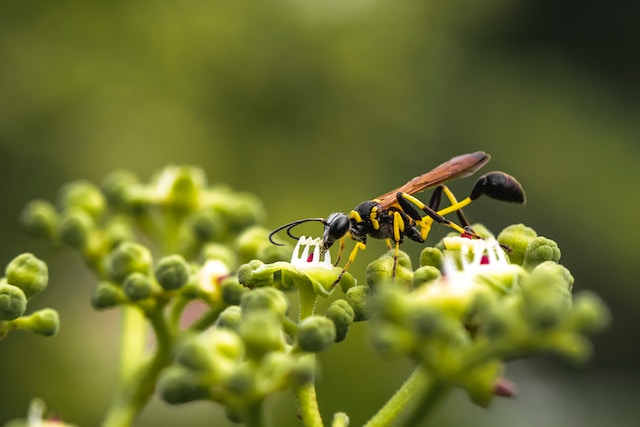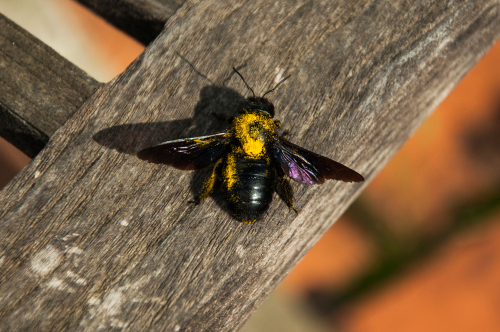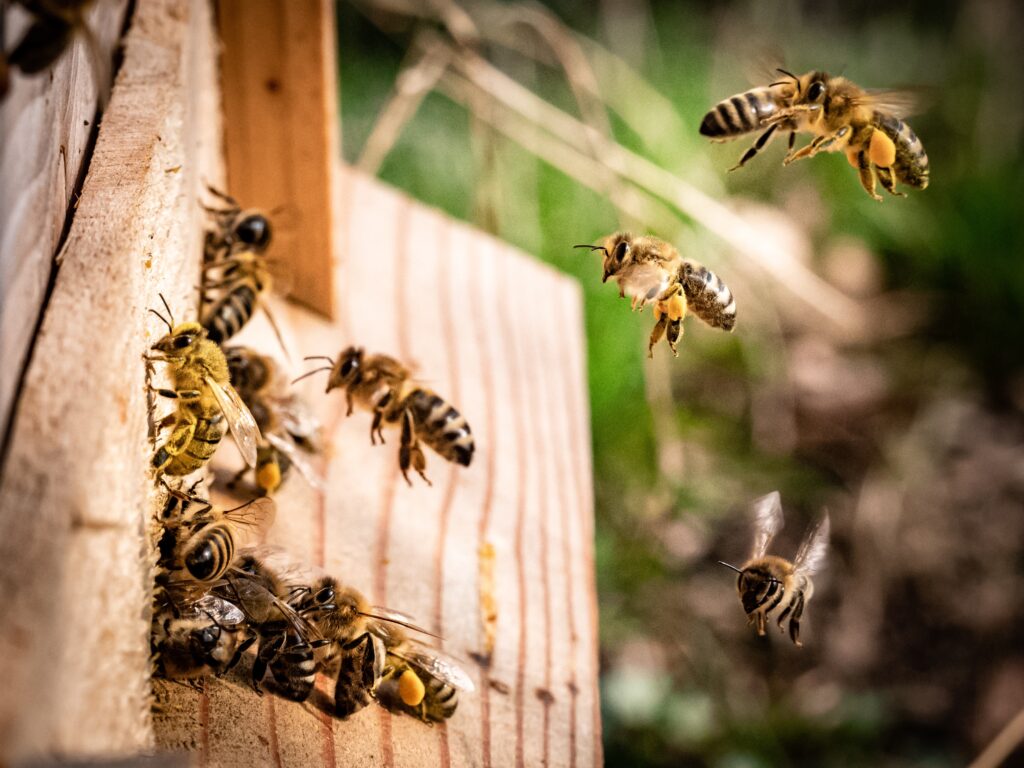Whether it’s stumbling upon a massive nest and fleeing from a cloud of angry yellow jackets, or a harrowing trip to the hospital following an allergic reaction to a sting, it seems like almost everyone has a horrific bee or wasp-related story to tell.
While it can sometimes seem that stinging insects have it out for us humans, most of the time stings are just reactions to a perceived threat, and most stinging insects won’t go out of their way to attack you. Indeed, in many ways, bees and wasps are good to have around since they pollinate flowers and keep various pest populations in check.
But sometimes they can get a bit close for comfort. Read on to discover tips for dealing with stinging insects in the state of Kansas.
Stinging Insects in Kansas
What Stinging Insects Are in Kansas City?
Kansas has a number of stinging insects. Wasps, bees, hornets, and yellow jackets are most active during the warmest months of the year. Most stinging insects will not sting unless provoked. That becomes difficult when they build their nest or hive in or on your home.

Bald-Faced Hornets
These aren’t true hornets; they’re actually a species of yellow jacket wasp. They build paper nests about the size of a basketball. They look scary but are relatively harmless unless provoked.

Cicada Killers
Also called cicada hawks, these are large, intimidating digger wasps that measure about 2 inches long, and are black or dark brown, with colorful yellow markings. Their name refers to a rather original approach they take to child-rearing: they paralyze a cicada with a sting, haul it back to their nest, and lay their eggs on it. The cicada is then used as food for the grubs, and usually remains alive throughout the whole ordeal. Fortunately, these wasps lack the nest-guarding instincts of honey bees and hornets, so you can walk through areas where they are active without attracting attention.

Yellow Jackets
Yellow jackets are very common in Kansas. They usually build their nests underground. The yellow jacket is aggressive, and unlike most bees, they can sting multiple times. They will often mark supposed “intruders” with pheromones that attract other yellow jackets, who will administer stings of their own.

Paper Wasps
Paper wasps are small and slender, but their sting is painful. They make small paper nests that look like an umbrella. They are most active from March to October, and at Trutech we offer a monthly pest control service.

Mud Dauber Wasps
These wasps elect to build their nests with mud, molded into place with their mandibles. Like paper wasps, they are not aggressive, but can become belligerent when threatened. Stings are uncommon.

Carpenter Bee
Carpenter bees are very large but harmless. They damage wood byboring holes for their young. They look very similar to bumble bees, except they have a smooth, black abdomen, while the abdomen of a bumble bee is hairy with a yellow band.

Honey bees
Honey bees have very large colonies up to 80,000! They swarm In the spring and can get into houses. They are not native insects or protected in any way. Most come from bee hives and are the insect equivalent of an escaped chicken or cow. Bee keepers will remove hives for free, but if the hive is inaccessible we need to kill the colony and cut out the honey.
Why Do I Have Wasps, Yellow Jackets or Bees?
Bees, wasps, yellow jackets, and hornets are exceedingly common, especially in human-occupied areas. If you have what seems to be an excessive number of stinging insects around your house, it’s probably because your property provides them with food sources and nesting sites.
Where Will I Find Wasp Nests on My Property?
Most solitary wasps build their nests underground. Most social wasps build their nests above ground. These nests will be located in sheltered, hidden locations, especially overhangs, such as those found in dense bushes or trees, wall voids, attics, sheds, barns, or under the eaves of a structure.

What Stinging Insect Is Underground?
Yellow jackets, ground hornets, and wasps typically build nests underground in areas that are concealed and protected. They often choose locations such as in an abandoned rodent burrow (yellow jackets cannot burrow or dig). They will also build their nest in bushes, trees, or shrubs.
If you notice yellow jackets flying in and out of a particular area, it could be a sign that they have built a nest there.
They are become aggressive in the fall.

A yellow jacket can build a nest above ground typically in a sheltered location, such as under the eaves of a building or inside a hollow tree. The nest can build a small, paper-like structure or a large, intricate nest with multiple layers. It is constructed out of wood fiber that the yellow jackets strip from tree bark and then mix with their saliva to create a pulp-like material.
Yellow jackets are often defensive and will aggressively attack anything that they perceive as a threat to their nest, making it important to avoid disturbing the area around the nest. If the nest needs to be removed, it is best to seek the help of a professional as yellow jackets can sting repeatedly and their stings can be dangerous to those allergic to them.
How Do I Get Rid of Stinging Insects in Kansas City?
Seeing a wasp nest on your property is not generally a cause for concern—if you’re a gardener, you might even want bees and wasps around, as they are pollinators and keep pest populations in check.
But finding stinging insects in an area frequented by humans or pets is a different story. For example, discovering a nest teeming with wasps under your porch swing is much more concerning than discovering a similar nest on a tree on the edge of your property.
If you discover a nest that will clearly need to come down, here’s what to do:
- Call an exterminator. If you are allergic to bees or wasps, or if you have any doubts about your ability to safely remove a wasp nest, call a professional. Bee stings have the potential to be very dangerous or even deadly, and you can develop an allergy at any stage of life.
- Put on some thick clothes. You might not have access to a full beekeeper’s suit, but at the very least, put on some thick, long pants and a long shirt before confronting a nest.
- Don’t use ladders. If the nest is well out of reach, it’s a bad idea to use a ladder to reach it, as you can easily fall off if the wasps swarm you. In this scenario, calling a professional is the best option.
- Use pesticide spray. Wasp-killing pesticide sprays are widely available at hardware, grocery, and convenience stores. First, come up with an escape route to be taken after the nest has been sprayed. Then target the nest with a stream of pesticide. Try to saturate the entire nest as quickly as possible, then vacate the area (this is best done at nighttime, when wasps are less active). Return to the site in about 24 hours to ensure there is no more wasp activity.
- Use insecticidal dust. Ground nests are easily controlled with a single application of insecticidal dust directed at the nest opening. Insecticidal dusts work well in these instances because the wasps pick the dust up as they enter the nest and bring it to the core of the nest.
Stinging Insect Prevention
To stop stinging insects from finding their way into your home, seal any entry points around windows and doors, make sure that screens are intact and installed in windows and doors, and place a cap on all chimneys.
Control bees, wasps, hornets, and yellow jackets in Kansas with these tips:
- Trim back overgrown vegetation so they nest away from the exterior of your home.
- Avoid planting shrubs and bushes right next to the exterior of your home, if possible.
- Many stinging insects are attracted to bright colored flowers; try not to plant too many of these flowers on your property.
- Remove water sources by fixing leaky pipes and making sure that gutters are not collecting water.
- Stinging insects are attracted to food scraps found in garbage; make sure that all outdoor trash cans have tight-fitting lids on them.
- Stinging insects are attracted to food scraps found in garbage; make sure that all outdoor trash cans have tight-fitting lids on them.
Exterminator vs Wildlife Control Operator in Kansas
Again, if you feel unsure about your ability to safely deal with a bee or wasp nest, make the wise choice and speak with a professional. Most exterminators or pest control companies can kill the stinging insect problem.
If the pests have build their nest or hive inside your home, you must remove it. Abandoned nests will attract other pests like roaches, rats, raccoons, or even a new colony of stinging insects. The honey in empty bee hives will melt and run down your walls.

At Trutech, our experts in Kansas City have removed bee hives from ceilings, under porches, on roofs, and attached to houses. Our team of experts has the experience and equipment to deal with a stinging insect problem of any scale, successfully remove the nest or hive, and clean up the mess left behind by the stinging pests.



